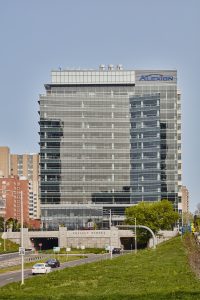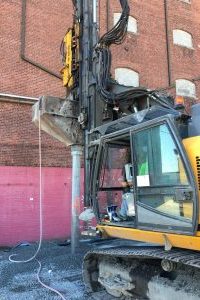Geopier® rigid inclusion ground improvement systems, such as grouted Rammed Aggregate Pier® elements (GAPs) or GeoConcrete® Columns (GCCs), can be an ideal solution for supporting heavy structures that are underlain by thick, soft, and compressible soil deposits such as organics or clay. Rigid inclusions can also be used in combination with ungrouted/uncemented Rammed Aggregate Pier (RAP) ground improvement to optimize overall structural performance and decrease construction costs by creating a stable subgrade for conventional shallow footing and slab-on-grade construction.
What Are Rigid Inclusions?
Geopier rigid inclusions (RIs) are stiff ground improvement elements comprised of an aggregate/grout mixture, cement-treated aggregate, or plain concrete. Rigid inclusions, combined with an engineered granular “footing pad” (or load transfer platform), transfer some of the foundation (or embankment) loads through soft soils to denser stratum and some of the load to the surrounding matrix soils. The RIs and matrix soils share the load based on their relative stiffness and load-carrying capacity.
Rigid inclusions can be used in conjunction with ungrouted/uncemented Rammed Aggregate Pier® (RAP) ground improvement systems to optimize performance and costs on a single project. These ground improvement systems provide an improved subgrade for conventional foundation support without the need for piles, structural grade beams, or structural slabs.
Rigid Inclusion Systems:

When Should Geopier Rigid Inclusions Be Considered For A Project?
Rigid Inclusions are best used when:
- Aggregate pier ground improvement cannot adequately control settlement in soft soil profiles (such as peat or organics, soft silt, or clay layers).
- Rigid inclusions (RIs) are typically at least 4 times stiffer than aggregate piers.
- RIs help efficiently transfer much of the load through soft soil layers into denser stratum due to their high stiffness.
- RIs are not susceptible to lateral bulging in peat or organic strata.
- Deep foundations (such as driven or drilled piles) have been specified for the project.
- RIs provide improved soil response rather than direct load support through the use of an engineered granular “footing pad” (or load transfer platform) installed between the rigid inclusions and footing or slab. As such, conventional shallow footing and slab-on-grade construction can be used rather than heavily reinforced (and more expensive) pile caps, grade beams, and structural slabs.
- High production rates and relatively low costs make RIs a viable alternative to deep foundations.
- RIs and conventional substructure construction can help get the project “out of the ground” in about half the time of deep foundations and structural slabs.
- Massive excavation/replacement has been specified for the project.
- RI installation can usually be accomplished with a displacement installation method that generates little to no spoil, thus reducing premiums associated with off-site soil disposal.
- RI installation does not require dewatering.
- On-site soils are impacted or contaminated.
- RI installation can usually be accomplished with a displacement installation method that generates little to no spoil, thus reducing premiums associated with off-site soil disposal.
- Grouted aggregate or concrete in the RIs is essentially non-permeable, eliminating any potential cross-contamination of groundwater aquifers and does not provide a preferred flow path for contaminants.
Recent Projects
100 College Street 14-Story Office Building and 10-Story Parking Garage
Location: New Haven, CT
Rigid Inclusion Technique: Geopier GeoConcrete Columns
Geotechnical Challenges: Insufficient Soil Bearing Capacity, Settlement Control, Unsuitable Soil Conditions
READ CASE STUDY
Assembly Row, Blocks 1-4 and 10

Location: Somerville, MA
Rigid Inclusion Technique: Grouted Rammed Aggregate Pier elements (GAPs)
Geotechnical Challenges: Insufficient Soil Bearing Capacity, Settlement Control, Shallow Groundwater Table, Unsuitable Soil Conditions
READ CASE STUDY
Warehouse Addition
Location: New Bedford, MA
Rigid Inclusion Technique: Grouted Rammed Aggregate Pier elements (GAPs)
Geotechnical Challenges: Insufficient Soil Bearing Capacity, Settlement Control, Shallow Groundwater Table, Unsuitable Soil Conditions
READ CASE STUDY



